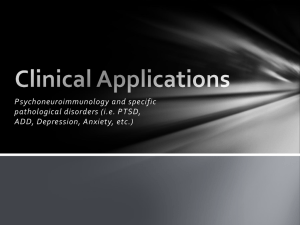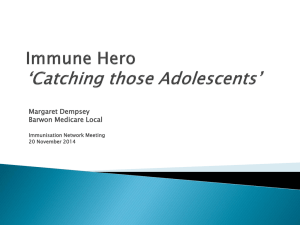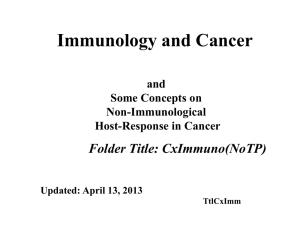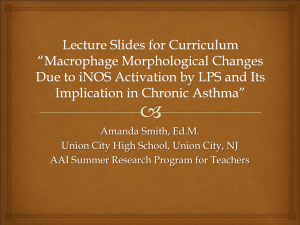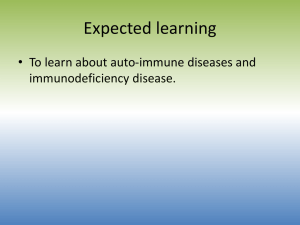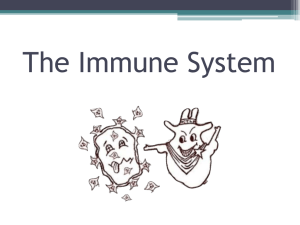I. Physiology of the Immune System
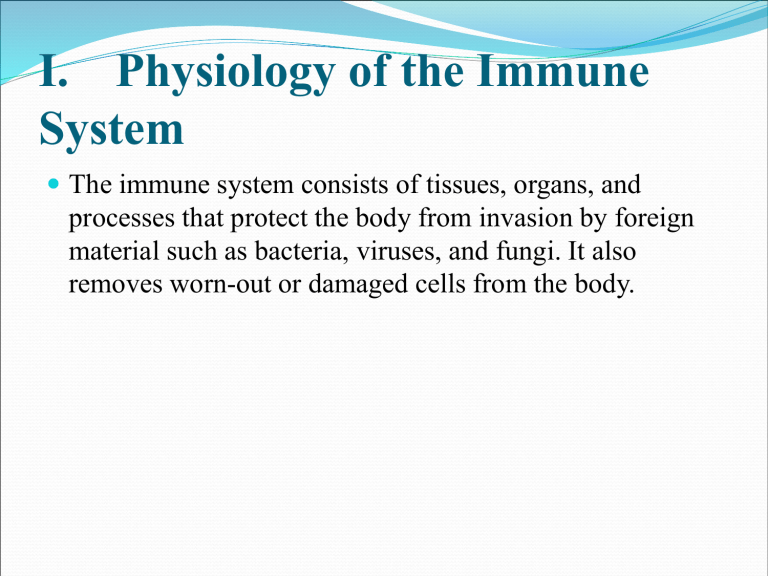
I.
Physiology of the Immune
System
The immune system consists of tissues, organs, and processes that protect the body from invasion by foreign material such as bacteria, viruses, and fungi. It also removes worn-out or damaged cells from the body.
A. Organs of the Immune
System
The immune system includes lymph (circulating fluid that contains a type of white blood cell called lymphocytes) and lymph nodes (interspersed oval capsule structures) through which lymph circulates
(see Figure 6.1).
Health Psychology, 6/E by Linda Brannon and Jess
Feist
Copyright
2007 Wadsworth Publishing, a division of Thomson Learning. All rights reserved .
A. Organs of the Immune
System
Various types of lymphocytes include T-cells, B-cells, and natural killer (NK) cells. The thymus, tonsils, and spleen are also involved with the production, maturation, or differentiation of the various types of lymphocytes.
B. Function of the Immune
System
The immune system is the body’s defense against foreign invaders, and it must be virtually 100% effective in destroying invaders (see Figure 6.2).
Health Psychology, 6/E by Linda Brannon and Jess
Feist
Copyright
2007 Wadsworth Publishing, a division of Thomson Learning. All rights reserved .
1. Nonspecific Immune System
Responses
Phagocytosis (attack of foreign particles by granulocytes or macrophages) and inflammation (the sequence of events that restores damaged tissue) occur with a wide variety of invading particles.
2. Specific Immune System
Responses
Contact with invading microorganisms sensitizes T-cells, allowing the cytotoxic T-cells to subsequently recognize these invaders and creating a specific immunity called cellmediated immunity.
After coming into contact with an antigen, B-cells differentiate into plasma cells that manufacture specific antibodies that mark invading cells for later destruction
(see Figure 6.3).
2. Specific Immune System
Responses
Even after the invaders have been destroyed, the immune system keeps the critical information that allows future manufacture of antibodies, creating immunity to an invader that can persist for years (see Figure 6.4).
3. Creating Immunity
Vaccination is the introduction of weakened or dead bacteria or viruses, thus creating a specific immunity.
Interferon, a protein produced by viral infection, may be capable of producing a more general immunity to a variety of viral infections, and recombinant DNA research with interferon may enlarge the possibilities for creating immunity.
C. Immune System Disorders
Failures of the immune system leave a person open to infection from viruses, bacteria, fungi, and parasites.
The immune systems of some children fail to develop, and acquired immune deficiency syndrome (AIDS) destroys the immune systems of adults and children.
C. Immune System Disorders
Allergies are the result of overactive immune systems, and autoimmune diseases result when the immune system fails to distinguish body cells from invaders and starts to attack and destroy body cells.
The immune surveillance theory hypothesizes a critical role for the immune system in the development of diseases. With cancer, for example, the immune system fails to control the proliferation of cancerous cells.
II. Psychoneuroimmunology
Psychoneuroimmunology is the interdisciplinary field that focuses on the interactions among behavior, the nervous system, the endocrine system, and the immune system.
A. The History of
Psychoneuroimmunology
Until the 1960s, the immune system was thought to be independent of the nervous system and uninfluenced by behavior.
In 1975, Ader and Cohen demonstrated that the immune system could be conditioned, laying the foundation for psychoneuroimmunology.
A. The History of
Psychoneuroimmunology
One way that the nervous system and immune system communicate is through cytokines, chemical messengers secreted by the immune system.
B. Research in
Psychoneuroimmunology
Research in psychoneuroimmunology has attempted to reveal the interactions among behavior, the nervous system, the endocrine system, and the immune system by demonstrating that behavior can affect the immune system and that disease can result from these effects.
B. Research in
Psychoneuroimmunology
Research has demonstrated that behavior can depress immune system function, and a growing body of research has linked lowered immune system function and subsequent disease.
Depression of the immune system appears to be easier than enhancement of the immune system’s functioning.
B. Research in
Psychoneuroimmunology
Research in psychoneuroimmunology should also demonstrate that behavior affects immune system functioning and that such impaired immune function causes disease. A substantial body of research has demonstrated the link between behavior and depressed immune function and also between lowered immune function and disease.
B. Research in
Psychoneuroimmunology
Most studies in psychoneuroimmunology have demonstrated that behavior can suppress immune system function, but a few studies have used behavioral interventions to attempt to boost immune system function.
C. Physical Mechanisms of
Influence
The link between behavior and depressed immune function must occur through some physical mechanism, and research has examined both the action of the peripheral nervous system during stress and neuroendocrine responses in the brain.
C. Physical Mechanisms of
Influence
The immune system also signals the nervous system by way of cytokines. Thus, the interrelationship between nervous system and immune system is complex, with many possibilities for mutual influence (see Figure 6.5).
III. Does Stress Cause Disease?
Disease is caused by many factors, and stress may be one of those factors. However, most people at risk from stressful experiences do not develop a disease.
Although stress and disease are related, stress does not seem to be a major cause of either physiological or psychological disorders.
III. Does Stress Cause Disease?
Just as most smokers will not die of lung cancer, most people who experience high levels of temporary stress will not develop a disease.
In addition, many people who become sick have not experienced unusually high levels of stress immediately prior to their illness.
A. The Diathesis-Stress Model
Why does stress affect some people, apparently causing them to get sick, while leaving others unaffected?
A. The Diathesis-Stress Model
The diathesis-stress model offers a possible answer to this question.
This model suggests that some individuals are vulnerable to stress-related diseases because either genetic weakness or biochemical imbalance inherently predisposes them to those diseases.
A. The Diathesis-Stress Model
Whether inherited or acquired, the vulnerability to stress-related disease is relatively permanent.
For people with a strong predisposition to a disease, even a mild environmental stressor may be sufficient to produce an illness episode.
B. Stress and Disease
Some evidence exists concerning the link between stress and headache, infectious disease, cardiovascular disease, diabetes mellitus, premature birth, asthma, and rheumatoid arthritis.
In addition, stress shows some relationship to negative moods and mood disorders such as depression and anxiety.
1. Headaches
Headaches are a common experience, but most do not require medical attention.
Of those that do, tension and migraine headaches are the most common, and stress is a factor in both.
Daily hassles are more important than life events in producing chronic headaches, and research shows that vulnerability and stress interact to produce headaches.
2. Infectious Disease
Early research indicated that stress was a weak factor in developing infectious disease.
However, later research by Sheldon Cohen and his associates intentionally exposed people to respiratory viruses and found that those who were the most stressed prior to the exposure were the one's who were most likely to develop an infectious disease.
Disease
3. Cardiovascular
Cardiovascular disease has a number of risk factors, some of which are related to stress.
For people with preexisting CVD, stress increases their risk of heart attack.
A large international study identified several psychological stressors as a risk for heart attack; these risks included workplace and home stress, financial problems, major life events, depression, and external locus of control.
a. Hypertension
The relationship between stress and temporary increases in blood pressure is stronger than the evidence for stress as a factor in chronic hypertension.
Some evidence exists showing that chronic stress may be related to hypertension, but other factors, such as sodium intake, may interact with stress to raise the risk for hypertension.
b. Reactivity
Reactivity is the tendency for some people to react more strongly than other people to stress.
Reactivity is a stable characteristic in some people, with blood pressure, heart rate, and other biological responses used as indexes of reactivity.
Educational level, socioeconomic level, and ethnic background all relate to reactivity, putting those with low educational and income levels and African Americans at increased risk for heart disease and stroke.
Discrimination and stereotype threat may be factors that affect the reactivity of African Americans, increasing their vulnerability.
4. Other Physical Disorders
Stress may be implicated in the development and management of Type 1 and Type 2 diabetes mellitus and rheumatoid arthritis. Stress experienced by pregnant women increases the chances of premature delivery.
Stress may contribute to the development of asthma through effects on cytokines involved in inflammation.
4. Other Physical Disorders
Rheumatoid arthritis is an autoimmune disorder, and stress contributes to this disorder in both direct and indirect ways.
C. Stress and Psychological
Disorders
Stress is also related to several psychological disorders in ways that the diathesis-stress model predicts: Some people exposed to stressors develop these disorders, whereas most do not.
Research has also suggested that cytokines in the immune system play a role in mood and the development of psychological disorders.
1. Depression
Stress is one factor that makes people vulnerable to depression, but effective coping protects against depression.
The tendency to ruminate over negative events increases the risk for depression, and genetic vulnerability is also a risk.
1. Depression
Chronic workplace stress, poor health, and caregiving are stressors that increase the risk for depression.
The route through which stress may produce depression is through the effect on proinflammatory cytokines produced by the immune system, which is related to the development of depression.
2. Anxiety Disorders
Anxiety disorders include panic attack, agoraphobia, generalized anxiety, obsessive-compulsive disorders, and posttraumatic stress disorder (PTSD).
PTSD is, by definition, related to stress, and PTSD also produces suppression of the immune system.
Stress is less clearly related to the other anxiety disorders, partly because the overlap between anxiety and depression makes it difficult to disentangle these two problems.



